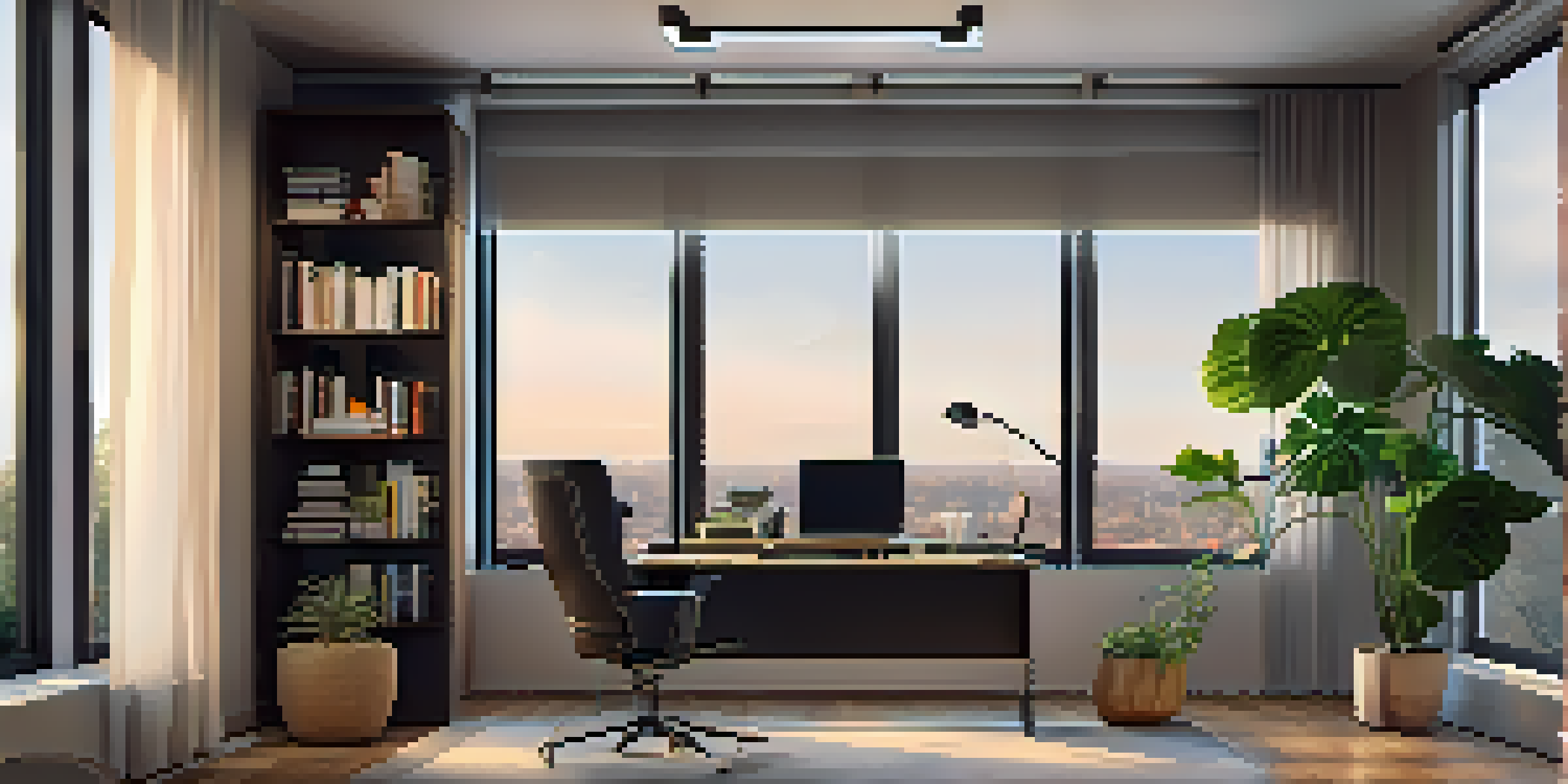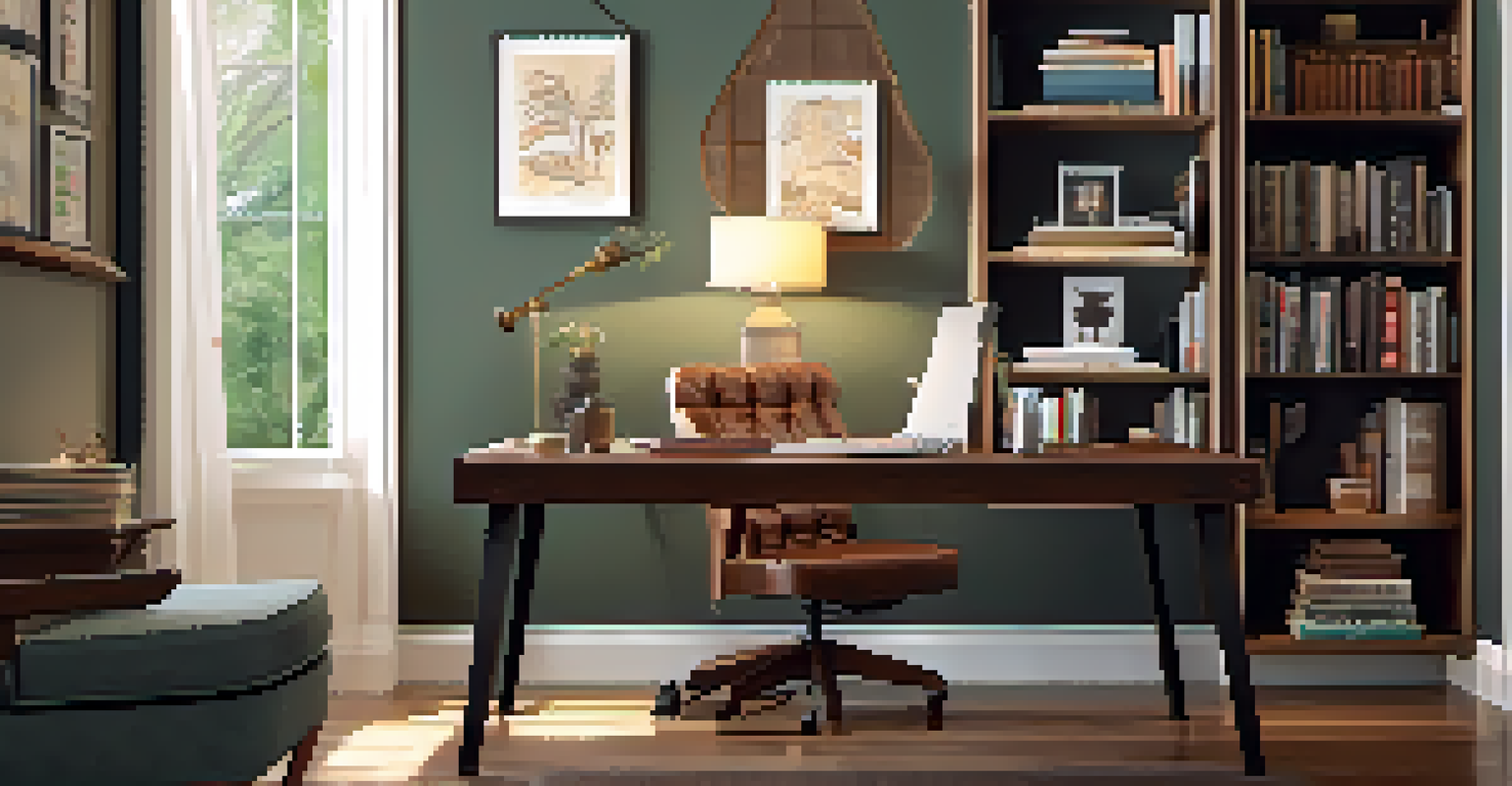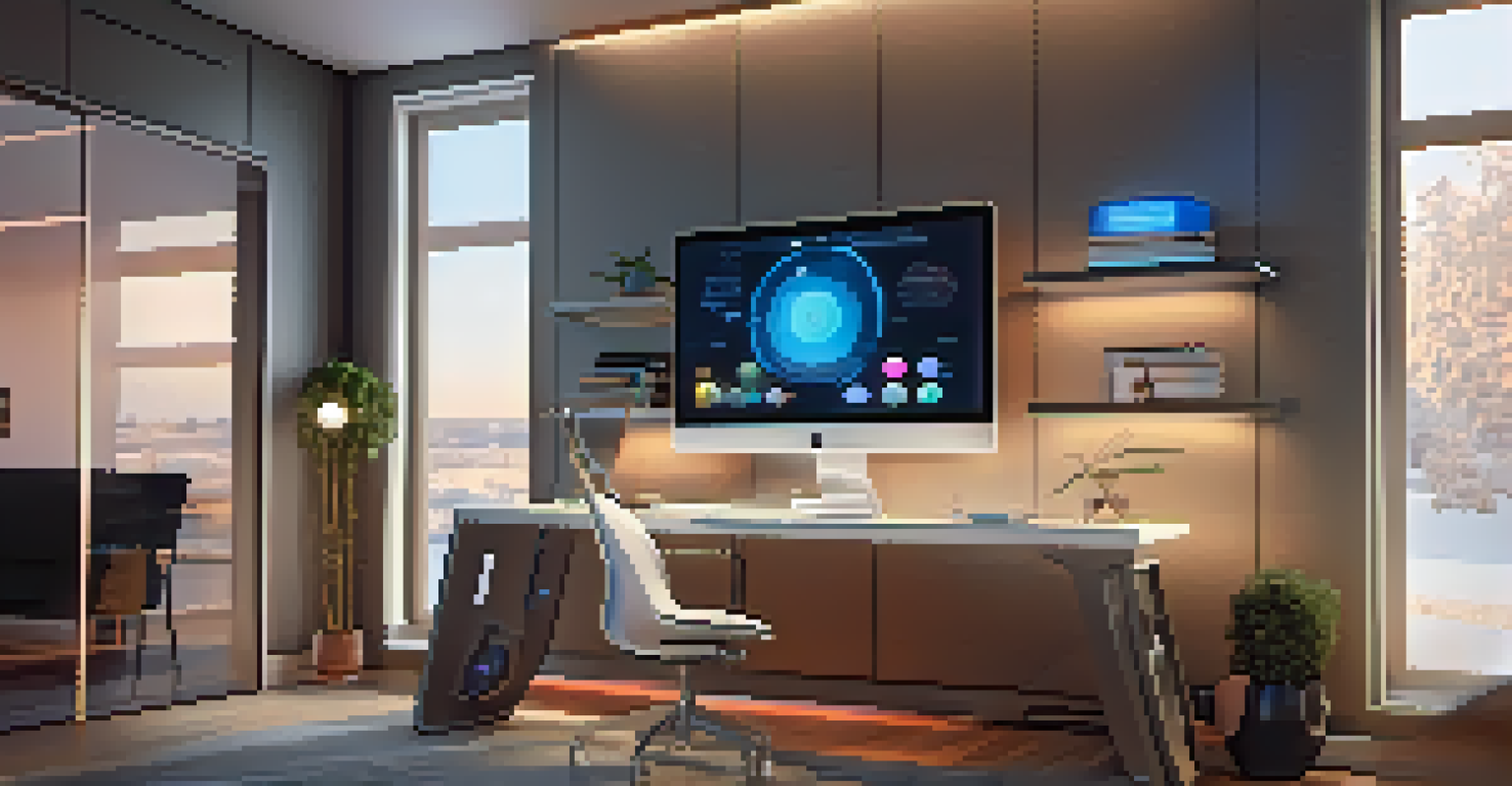Incorporating Smart Lighting in Your Home Office Design

Understanding Smart Lighting and Its Benefits
Smart lighting refers to lighting systems that can be controlled remotely through apps or voice commands. This technology allows you to customize your lighting based on your preferences, time of day, or even your mood. By incorporating smart lighting in your home office, you can create an environment that enhances your productivity and comfort.
Lighting is a key factor in creating a productive work environment, affecting everything from mood to focus.
One of the significant benefits of smart lighting is energy efficiency. Many smart bulbs use LED technology, which consumes less energy than traditional bulbs and lasts much longer. This not only reduces your electricity bills but also minimizes your carbon footprint, making it an eco-friendly choice for your workspace.
Additionally, smart lighting can improve your overall well-being. By adjusting the brightness and color temperature to mimic natural light, you can reduce eye strain and fatigue, which are common issues for those spending long hours in front of screens. This thoughtful enhancement can lead to a more enjoyable and productive work experience.
Choosing the Right Smart Lighting Solutions
When selecting smart lighting for your home office, consider the type of work you'll be doing. For tasks requiring focus, like writing or designing, bright, cool white light can help keep you alert. Conversely, if you're in a more relaxed setting, such as for video calls or brainstorming sessions, warmer tones can create a cozy atmosphere.

It's also essential to think about the various types of smart bulbs available. Some popular options include smart LED bulbs, smart light strips, and smart lamps. Each type serves different purposes and can be strategically placed to enhance your workspace—light strips can accentuate shelving, while smart lamps can provide direct lighting for your desk.
Enhance Productivity with Smart Lighting
Smart lighting can help regulate your circadian rhythm and improve focus by mimicking natural daylight.
Lastly, compatibility with your existing smart home system is crucial. Ensure the smart lighting solutions you choose work seamlessly with other devices like smart speakers or home assistants. This will allow you to control your lighting effortlessly, whether you're adjusting dimness with a voice command or scheduling it to turn on and off at specific times.
Creating Layers of Light in Your Home Office
Layering light in your home office is all about using different types of lighting to create a balanced environment. You can achieve this by combining ambient, task, and accent lighting. Ambient lighting provides overall illumination, task lighting focuses on specific work areas, and accent lighting adds a decorative touch or highlights certain features of your office.
The most effective way to improve your productivity is to optimize your environment, and lighting plays a crucial role in that.
For instance, consider using a smart ceiling fixture for ambient light, which offers a general glow throughout the room. Then, add a smart desk lamp for task lighting, ensuring you have focused light when working on detailed tasks. Finally, you can incorporate smart LED strips along bookshelves or behind your desk to serve as accent lighting, creating a visually appealing and functional workspace.
This layered approach not only enhances the aesthetics of your home office but also improves functionality. By adjusting each layer of light independently, you can tailor your workspace to suit various activities—whether you’re deep in concentration or taking a break with a book.
Utilizing Smart Lighting for Productivity
Smart lighting can significantly impact your productivity levels throughout the day. By programming your lights to mimic the natural progression of daylight, you can help regulate your circadian rhythm, leading to better focus and energy levels. For example, bright, cool lighting in the morning can help kickstart your day, while softer, warmer tones in the evening can signal it's time to wind down.
You can also set specific lighting scenes for different tasks. For instance, a 'focus' scene could involve bright, direct lighting for when you're tackling complex projects, while a 'relax' scene could dim the lights and warm the colors for when you're brainstorming or taking a break. This versatility allows you to create an environment that adapts to your needs.
Choose Lighting for Your Workspace
Selecting the right type of smart lighting based on your tasks can create a more functional and comfortable home office.
Moreover, using timers or motion sensors can enhance this productivity boost. You could set your lights to gradually brighten as you arrive at your desk each morning, creating a welcoming atmosphere that motivates you to start your workday on the right foot.
Integrating Smart Lighting with Your Home Office Decor
When incorporating smart lighting into your home office, it's essential to consider how it fits with your overall decor. Choose fixtures and bulbs that complement your design style, whether modern, minimalist, or traditional. The right lighting can enhance your decor while providing the functionality you need.
For example, if your office features a sleek, modern design, opt for smart LED bulbs in clean, geometric fixtures. Conversely, if your space has a more traditional feel, vintage-style smart bulbs in classic lamps can add warmth and charm. This attention to detail can transform your workspace into a cohesive and inviting environment.
Additionally, consider the placement of your smart lighting. Use adjustable fixtures that allow you to direct light where it's needed most, enhancing both functionality and aesthetic appeal. This thoughtful integration can make your home office a place where you genuinely enjoy spending time.
Maintaining Your Smart Lighting System
Like any technology, maintaining your smart lighting system is crucial for optimal performance. Regularly check for software updates to ensure your smart bulbs and fixtures function correctly. Many manufacturers release updates that improve efficiency and introduce new features, so staying informed is key.
It's also a good idea to clean your smart bulbs and fixtures periodically. Dust and grime can accumulate, diminishing brightness and affecting the aesthetic quality of your lighting. A simple wipe-down with a microfiber cloth can restore their shine and ensure you're getting the most out of your smart lighting setup.
Maintain Your Smart Lighting System
Regular maintenance, including software updates and cleaning, is essential for optimal performance of your smart lighting setup.
Lastly, monitor your energy usage and adjust your settings as necessary. Many smart lighting systems offer insights into energy consumption, helping you identify patterns and make informed decisions on how to optimize your usage. This proactive approach not only enhances your experience but also contributes to energy savings.
The Future of Smart Lighting in Home Offices
As technology continues to advance, the future of smart lighting in home offices looks promising. Innovations such as AI-driven lighting systems will allow for even more customization and automation, adapting to your behavior and preferences over time. Imagine a lighting system that knows when you typically start your workday and adjusts itself accordingly without you having to lift a finger.
Furthermore, the integration of smart lighting with other smart home devices will create a more cohesive and intelligent living space. For example, your lighting could sync with your calendar, automatically adjusting based on your scheduled meetings or tasks. This level of interconnectivity can enhance not just your workspace but your entire home environment.

Finally, as sustainability becomes increasingly important, smart lighting technology is likely to evolve to include even more energy-efficient options. Expect to see advancements that further reduce energy consumption and promote eco-friendly practices, making your home office not only smarter but also greener.